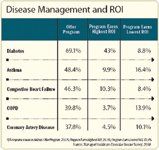State of the Industry 2009: Disease Management
Evaluating the return on investment in disease management can be quite complicated, and survey results are suggestive rather than conclusive.
Evaluating the return on an investment in disease management can be quite complicated, and survey results are suggestive rather than conclusive. For example, disease management's return on investment often fluctuates from year to year, says Paula Sauer, vice president for care management at Medical Mutual of Ohio (MMOH) and an MHE editorial advisor.
"You may see a high return on investment initially in disease management, but then over time it often decreases," she says.
Another significant factor is that some plans have high turnover in membership, and they might see a higher return on their DM investment for the newly enrolled, compared to longer-term members.
HIGHEST RETURN
While 10.3% of respondents said that congestive heart failure showed the highest return on their disease management investment, 8.4% found it had the lowest return.

"These patients frequently go to the emergency room, and they frequently get admitted," she says. "Your admissions costs offer your greatest potential reductions, which drives your ROI. Admission costs are actually a much more significant factor than ER visits."
Peer-reviewed literature supports congestive heart failure as a good candidate for high ROI, according to Ariel Linden, DrPH, MS, president of the Linden Consulting Group.
"However, it must be an effective program," he says. "That means it should identify potential participants using data from a health risk assessment process, as well as from claims. In addition, DM programs should incorporate motivational interviews and address barriers to enrollment, such as the member's readiness to change."
He recommends frequent contacts with high-risk members through remote telemonitoring, and systematic approaches to increase physician involvement.
Linden suggests that chronic obstructive pulmonary disease (COPD) is another candidate for high ROI, since these patients often have a high number of admissions. However, only 3.7% of respondents said COPD had the highest ROI.
The largest percentage of respondents ranked diabetes as the condition with the highest return. Diabetes is tricky to manage because when diabetics are admitted to the hospital, it's generally for related conditions, such as hypertension or a coronary event.
"A disease management program that focuses just on diabetes and excludes these other components is obviously missing the boat," Linden says.
Almost 10% of survey respondents found that asthma had the highest return on their disease management investment, while 16.4% found it have the lowest return. Sauer finds that in her own experience, asthma has been the most difficult condition to see a significant ROI, because there are issues that make asthma costs hard to control.
"ER visits are going up, and there are many differences across physician practices in how they prescribe medications for asthmatics," she says. "In addition, I think we're seeing an increase in asthma nationally due to of environmental issues."
Why Patient Registries Need to Make the Move From Tactical to Strategic Research Initiatives
September 6th 2022The one-sided, research-oriented approach has to change so patients have ready access to dashboards with their disease histories and pre-visit documents tailored to the patient questions.
Read More
Study: Patients with High Deductible Plans More Likely to Delay Care
September 7th 2021Patients faced with high out-of-pocket costs sometimes delay seeking care for appendicitis or diverticulitis, which can result in higher overall costs, increased risk of mortality, and a worse quality of life.
Read More